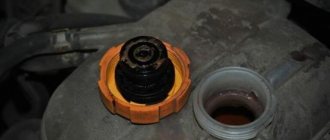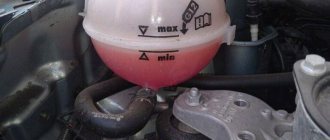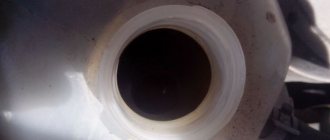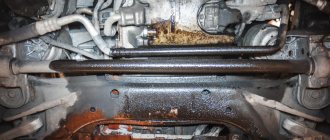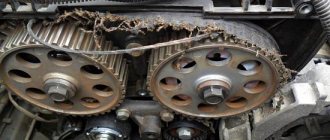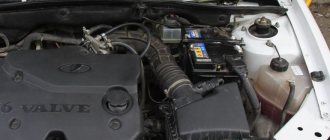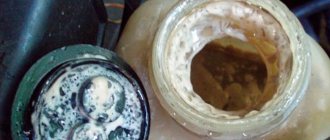Sometimes, while inspecting the level of antifreeze in the system, the driver observes a change in the color of the refrigerant. If you see bubbles, a brown tint, and traces of oil on the tank cap, then congratulations, you have unpleasant problems. Antifreeze got into the oil. The problem also has other signs, but it is important to know not only this, but also what the cause of the problem is.
When I encountered such a violation, the first thing that interested me was whether it was possible to drive a car. In general, if trouble does arise, the information presented in my review will be very useful.
The main signs indicating that oil has entered the antifreeze
The most important sign of the appearance of oil in antifreeze is a change in the color of the liquid. In addition, bubbles appear in the refrigerant. If traces of oil are clearly visible on the neck of the expansion tank, then we can say with confidence that oil has leaked into the antifreeze fluid. If these signs are not convincing, then there are other symptoms:
- the coolant level in the tank has decreased;
- white smoke began to appear from the exhaust pipe;
- The color of the oil on the dipstick has changed significantly.
Two of these indicators are checked using a special probe. If the leak is not visually observed, then the reasons may be completely different. Sometimes the presence of oil in antifreeze is indicated by the condition of the spark plugs. The elements will be moist and have a sweetish odor.
[custom_ads_shortcode1]
Taxonomy
Taxonomic position
Taxonomic scheme
(according to APG II System):
| 17 more families, including sedges, cattails | about 15 more tribes, including the feather grass , oat family , and bluegrass | Two-row barley, maned barley, mouse barley and other types | |
| order Poaceae, or Poagrass | subfamily Poagrass | genus Barley | |
| Department Flowering, or Angiosperms | family Poaceae, or Poagrass | tribe Wheat | dbl Common barley |
| 44 more orders of flowering plants | five more subfamilies, including Bamboo, Rice | 26 more genera, including Rye, Wheatgrass, Wheatgrass, Wheat |
Intraspecific taxa
The following subspecies are distinguished:
- Hordeum vulgare subsp. spontaneum - Wild barley basionym
- — Six-row barley
Two widespread cultivated varieties of common barley are two-row barley, native to Western Asia, and six-row barley, native to East Asia. In both varieties, the spikelets sit in threes on both sides of the spike shaft, forming six longitudinal rows along the spike. However, in two-row barley, like in wild barley, only two of the six spikelets sitting next to each other are fertile, from which caryopsis develops, the other four are sterile and reduced to glumes, so two rows of grains ripen on the ear, and four rows of scales are visible - according to two rows on both sides of the ear. In six-row barley, all six adjacent spikelets are fertile, and a ripe spike has six rows of grains.
Reasons for coolant getting into engine oil
Before we begin to study the question of how to diagnose a malfunction and what to do to fix it, let’s consider the main reasons for antifreeze getting into the engine oil. This will, to a certain extent, help us correctly localize the breakdown in order to make the right decision on how to minimize the consequences for the power unit.
In principle, there are few such reasons:
- loss of integrity of the gasket separating the two main parts of the motor: the upper (block head) and the lower (the block itself). In a particular case, in the event of such a malfunction, the coolant will not flow out at all, that is, if the antifreeze level drops, a visual inspection of engine parts and subsystems will be ineffective. We have already said that the line through which antifreeze circulates is closed, separate and sealed. But since the motor consists of two parts, and its internal geometry is quite complex, there is at least one large joint (between the BC and the cylinder head), which can be considered a potential source of depressurization of the cooling system. Initially, a moderately soft gasket is installed between these halves (made either from thin sheet metal or from paronite with reinforcement and a metal edging around the perimeter), which does not allow either mutual penetration of technical fluids or their leakage out. Damage to this gasket is one of the main reasons for depressurization of the cooling circuit, and in this case, antifreeze will enter the working cylinders - the responsibility of the engine oil. the reasons for damage to the gasket can be different, from burnout (due to the slightest inaccuracies when installing the gasket) to violation of the ideally flat geometry of the seat;
- the occurrence of defects in the block head. As a rule, such deformations occur mainly in the area directly adjacent to the lower part of the power unit, that is, to the cylinder block. The consequences of such defects are predictable - deterioration of the tightness of the seal to the seating planes of the gasket. At the same time, even without being damaged, it will gradually begin to leak coolant (due to its much lower viscosity than engine oil). In this case, there will definitely be no external signs of a leak, so if you find an antifreeze leak, you will definitely not be able to quickly localize the place where it is leaking. If the curvature of the seat is minimal, there will be very little leakage and the mixing of fluids will also be gradual. This is bad, because the consequences of such a mixture of oil and antifreeze will last much longer, and we will talk about them later. Such a malfunction can only be determined by troubleshooting, that is, after disassembling the cylinder head;
- Another reason why antifreeze gets into the oil is the occurrence of defects in the cylinder block body itself. These could be cracks located in areas of coolant circulation, which again occur when the engine overheats or as a result of a collision of the car with an obstacle. This malfunction is considered the most serious, since its identification will require dismantling the entire engine.
[custom_ads_shortcode2]
What to do if oil is mixed with antifreeze
Many car owners, having learned about the presence of a problem, do not always rush to fix it, believing that it is not serious enough to take urgent action. Of course, this opinion is wrong, and we will tell you why. Our advice is not to hesitate, start repairs immediately after detecting depressurization of the cooling system and antifreeze getting into the engine oil.
If the cause of the malfunction lies in the depressurization of the oil cooler gasket (in this case, oil gets into the antifreeze), it must be replaced. This is done in the following sequence:
- First of all, you should flush the cooling system line to get rid of any remaining lubricant. This procedure is performed using a special solution, which can be purchased at any auto store. The product is poured into the coolant reservoir;
- To ensure proper washing, we start the engine and let it run for 5, maximum 10 minutes - this should be enough to warm up the engine to operating temperature. This can be recognized by the fan turning on. We turn off the power unit;
- drain the flushing liquid;
- Place an empty container under the car in the radiator area, unscrew the drain plug and wait until all the coolant has drained out;
- Now you can begin dismantling the oil cooler. It is impossible to give specific advice here, since this element of the engine design is removed and installed differently on different models. How to do this can be found in the user manual;
- After dismantling the oil cooler, it can be disassembled and inspected, after which it can be thoroughly rinsed and cleaned. Worn seals should be removed, their seating area should be cleaned, and new gaskets should be installed, which must be purchased in advance for a specific car model;
- the next step is to dismantle the expansion tank and clean it. You should make sure that there are no significant defects on the body - otherwise it is better to replace the tank with a new one;
- We install the oil cooler and expansion tank in place and again flush the system with distilled water. To do this, pour it into the cooling system and start the engine, completely turning off the air flow into the cabin and using the maximum possible number of on-board electrical consumers (this will speed up the warming up of the power unit). As soon as the fan turns on, you should turn off all electrical appliances and activate the interior airflow. After about 10 minutes, the motor should cool down and the fan should turn off. We turn off the engine and wait until the distilled water cools down so that it can be drained;
- repeat the flushing procedure with distilled water again, drain it and fill in with fresh antifreeze;
- Finally, you need to try to get rid of air pockets, for which you will need an assistant. Start the engine and put him behind the wheel while you go to the engine compartment. Ask a friend several times, without skimping, to “gas” it, and at this time begin to squeeze the CO pipe with the expansion tank cap closed. After this, open the cap so that the air accumulated in the tank comes out.
If after replacing the oil cooler gasket the problem does not go away, antifreeze most likely gets into the oil through a damaged cylinder head gasket.
Oil film in the coolant expansion tank
Let's start replacing it (algorithm for VAZ-2109):
- dismantle the air filter housing;
- disconnect all the wires going to the engine, as well as the fuel supply hose;
- pour the coolant into a pre-prepared container;
- unscrew the manifold mounting bolts;
- disconnect the explosive wires;
- All we did was dismantle the so-called attachments, which will interfere with the removal of the cylinder head. To unscrew the GB itself, you need a hex wrench and a fairly thick wrench. You need to unscrew 10 bolts along with washers, then very carefully you can begin to remove the head by pulling it vertically up. It is important here to avoid distortions, so as not to bend the studs. A broken gasket can either remain on the block or stick to the seating surface of the head - it doesn’t matter. If it cannot be removed by hand, you should use a flat-head screwdriver, but be very careful not to leave scratches - these could become a source of future problems;
- We carry out a visual inspection of the head for signs of corrosion - if there are any, you need to get rid of the rust by performing milling/grinding procedures if necessary;
- clean the remains of the old gasket, degrease the seat;
- carefully install the new gasket, making sure that it coincides with the guides located at the corners of the BC;
- We also carefully put the head in place, and during docking with the block, make sure that the gasket does not move;
- We tighten the bolts with the obligatory use of a torque wrench, first with a force of up to 25 Nm, then tighten them sequentially to 85, 120 and 140 Nm;
- we install back the attachments;
- We start the engine, warm it up and only after that we take a test drive.
Consequences of oil contamination with antifreeze for the engine
The coolant is a mixture of alcohol and distilled water. If such liquid gets into the engine oil, it is quite obvious that the lubricating properties of the latter will deteriorate as a result of dilution with antifreeze. The longer this mixing lasts, the worse the MM will lubricate the rubbing parts of the power unit.
It is not difficult to predict that the consequences of antifreeze getting into the oil will be far from optimistic: accelerated wear of engine parts will lead to the need for premature engine overhaul, which is complex and expensive. If for owners of cars with high mileage and age, “capital maintenance” is, it’s fashionable to say, a routine operation, then the need to restore a fairly fresh engine can be a very unpleasant surprise for the car owner.
If there is a depressurization of the cooling system, in which coolant penetrates into the cylinders, and the driver did not notice this (which is quite likely), then with further operation of the car, quite soon clearly audible knocking noises will begin to be heard in the engine area. This is the result of wear on the crankshaft/camshaft bearings.
The mechanism for the occurrence of knocking is as follows:
If antifreeze begins to leak from the oil through the cylinders, the first to feel the deterioration in the lubrication properties of the MM are the liners, which are essentially slightly modified, highly loaded plain bearings. They are available both on the camshaft and on the crankshaft of the power unit. Poor quality lubrication will lead to the formation of scuffs on the inner surface of the liners, which will only increase over time. They are the source of bearing knocking.
If you disassemble the engine and remove the liners, you will find that the friction layer on their surface is practically absent, but there are quite deep scratches and burrs (bulges). Due to overheating, the color of the liner changes from gray to mottled brown.
If you continue to examine the surface of the bearings under a microscope, which provides a very high (thousand-fold) magnification, you will notice microscopic white balls with diameters of about 25-35 microns on the surface of the bearings. It is these particles that are responsible for the formation of scratches: at high speeds of rotation of the shafts they... Like a plow, they bite into the surface of the bearings, leaving grooves and burrs of appropriate sizes.
With such aggressive behavior, the friction layer’s chances of remaining unharmed tend to zero. You may ask, where did these balls come from, since at first they were not there? Let's figure it out.
According to spectrographic studies, these round abrasive particles consist of a mixture of sulfur, phosphorus, calcium and other elements. Although it is not a metal, the hardness of these particles is higher than that of the friction layer. So he is the one who suffers first.
Over time, the balls, which also experience heavy loads, become so compact that they become harder than the material used to make the liners. Then they attack the bearings themselves, destroying their surface.
Where did the particles come from? It turns out that it comes from additives contained in all modern oils. But the catalyst for their precipitation and grouping into large formations is antifreeze.
Plus, of course, high temperature. A verbal description of this process is not very informative, since we have little idea at what speed all these metamorphoses occur on a running engine, to what temperatures its rubbing parts heat up.
The second most important consequence of mixing oil and antifreeze in the engine is the formation of an emulsion, which is facilitated by the active mixing of these two liquids at high speeds. Why is this happening? As we already know, the coolant contains a considerable amount of water. And if oil is practically insoluble in water, then the same cannot be said about additives. This means that by partially dissolving in antifreeze, they reduce their concentration in the lubricating fluid. It is noteworthy that a minimum amount of coolant is required to start such a process.
Let us remember once again that all these processes occur at high temperatures. As they know in chemistry courses, thermal energy promotes the occurrence of various reactions between substances. That is why it does not take much time to form sufficiently strong compounds of phosphorus, sulfur, potassium, and zinc in the oil. The main condition is that antifreeze gets into the MM.
Mixing motor lubricant with engine coolant is a critical malfunction that requires immediate intervention and elimination. In other words, the car cannot be operated, only repaired. Although infrequent, this problem occurs on new and used cars. To avoid costly repairs, the car owner must clearly understand the procedure for his actions when oil is found in antifreeze.
Oil cooler failure
An oil cooling system is necessary for a car to maintain the lubricant at a temperature that is comfortable for the car to operate. If the oil cooler tubes are damaged and this system depressurizes, oil gradually begins to leak into the coolant. The first signal that the problem with your breakdown is in the oil cooler is the appearance of oil with bubbles in the coolant.
In this case, it is necessary to remove the pipes from the oil cooler, wash them and connect them together. The expansion tank of the system also needs to be completely cleaned. After these manipulations, the liquid is refilled. After a short period of time after restarting the car, you need to check whether the problem has disappeared or not. If yes, then the repair will cost you a little less, since you will have to deal exclusively with the cooler.
The coolant reservoir is dirty with grease
After removing the cooling system, you should thoroughly check all the pipes and, if there are cracks, weld them. This part of the work should be left to professionals. Poor quality repairs will end up costing you even more. Most often, copper tubes of the appropriate diameter are simply inserted into the places where cracks form in the oil cooler.
Sometimes oil gets into the antifreeze due to the fault of service station employees. If you discovered such a problem after visiting the station, it is worth checking whether engine oil has been added to the cooling system of your car. To do this, the liquid from the oil cooler is completely drained, and the system itself is thoroughly washed. In the final part of the work, you just need to pour new antifreeze into the engine.
How to fix the problem?
There are several ways to deal with the problem. Some manipulations are very complex and to solve them you should contact a service station, while some are easy to do yourself. The solution to the problem can be as follows:
- A burnt gasket can be easily replaced. It is quite possible to do this at home. True, here you will have to remove the cylinder head and have a torque wrench on hand.
- Grind the block head. This is only available for minor deformations. If the cylinder head is seriously damaged, then it will have to be changed.
- Performing or replacing the cylinder block.
The two extreme operations cannot be performed with your own hands. This will require serious equipment. It’s better to hire a master for the job. It is important to remember that “self-medication” can lead to the real problem and other damage.
[custom_ads_shortcode1]
Consequences of antifreeze getting into the cylinder block
It doesn’t matter what kind of liquid gets into the engine, it could be ordinary antifreeze or modern expensive antifreeze, the consequences will be identical. Further operation of the vehicle in the usual sense is not permitted. Coolant (hereinafter referred to as coolant) cannot harm the engine, even taking into account the aggressive and toxic components included in its composition. The problem is that ethylene glycol, which most coolants are made of, when mixed with engine oil, is converted into a solid, insoluble component, similar in action to abrasive materials. All rubbing parts quickly wear out and fail.
White emulsion on the plug: a clear sign of coolant in the oil
The second problem is a kind of scale or emulsion in the form of deposits on the walls of oil lines and numerous channels. The filters cannot cope with their task because they are simply clogged, the oil circulation is disrupted and, as a result, the pressure in the system increases.
The next problem is dilution of the engine oil, as a result of which the washing, lubricating, protective and other properties are lost. All this together invariably leads to overheating of the power unit and deformation of the cylinder block and its head. It doesn’t matter at all whether the engine is gasoline or diesel, the consequences will be similar.
How to prevent a malfunction from occurring?
You can avoid breakdowns if you take into account tips and recommendations for using antifreeze. The very first rule is that you absolutely cannot add antifreeze to the tank if it is not compatible with the composition already used. It is imperative to follow all manufacturer’s recommendations regarding the materials used.
Masters advise regularly performing car maintenance work. You need to carefully monitor how the car behaves and what symptoms appear. When signs indicating a violation appear, it is necessary not to continue driving the car, but to begin repairs.
Since the repairs may require quite serious repairs, it is better to immediately contact knowledgeable people. Specialists will quickly find the leak and be able to determine the causes. The repair technicians will also be able to carry out repairs to a higher quality. The service station has the necessary equipment, and the room is suitable for repair work.
[custom_ads_shortcode2]
Remedies
In the vast majority of cases, the cause is the cylinder head gasket, and it will require replacing it and restoring the tightness of the cooling system. It is inexpensive, and replacement will not cost a fortune, especially for a Russian-made car. The most difficult thing is removing the head, because you need a special torque wrench to control the force when tightening the nuts. You also need to take into account the sequence in which the nuts on the studs are unscrewed and then tightened.
Changing the gasket is not enough and you have to grind the plane of contact of the cylinder head to the block; most likely, if the seal is damaged, the “head” will move. In this situation, you can no longer cope on your own; you need to attract experts. They will carry out troubleshooting, and if it turns out that the head is severely deformed, grinding will no longer help, and you will have to replace the cylinder head. If antifreeze gets into the engine due to cracks in the block, then there is only one option for eliminating the leak: replacing the block, and in most cases this means installing a new or contract engine.
Video: Consequences of antifreeze getting into the engine
The ingress of antifreeze is not an exceptional case and occurs everywhere; even a novice motorist can determine the malfunction. The solution to the problem can be different and differ in both complexity and cost of repair. You should not delay diagnostics if any symptoms appear; this is fraught with more serious consequences, including replacing the engine.
Why does coolant get into the car oil?
The reasons why antifreeze went into the oil may be the following:
- The cover is burnt out. Between the cylinder head and the cylinders there is a metal lining. High temperatures in the combustion chamber and cooler increase the wear of this spare part. If you operate the car correctly, the lining will last approximately one hundred thousand kilometers. However, if the part is constantly overheated or filled with low-quality coolant, the part becomes deformed and the coolant goes into the lubricant.
Buy spare parts only from reliable retail outlets. Do not use the services of car services that employ employees whose qualifications are questionable.
Signs
If antifreeze gets into the oil, how can you tell? There are several signs to look out for:
- Coolant level. On a serviceable engine, it should not be changed during operation. However, if the level decreases, albeit slightly, this may indicate that antifreeze is getting into the engine oil.
- Traffic fumes. The exhaust becomes whiter and thicker. When the engine operates, a specific steam is generated. But you need to understand that this phenomenon is considered normal in severe frost. However, if the temperature outside is above zero, this is a clear sign that antifreeze is getting into the oil.
- Candles. The electrodes of the spark plugs will be filled with antifreeze and will emit a characteristic odor.
- Oil. If antifreeze gets in, it changes its color and structure. Usually the oil turns almost white.
- Emulsion on the oil filler neck. It may resemble a thick “mayonnaise”.
What to do
The method for eliminating an antifreeze leak depends on the cause of its occurrence. The simplest situation is a burnout or rupture of the gasket. It cannot be repaired, so the gasket should be replaced.
If a deformation of the cylinder head occurs, most often you cannot do without the help of a specialist, since performing this action incorrectly will lead to failure of the part. A deformed cylinder head will require grinding on a special machine. But if the defects are serious, it is necessary to remove more than the permissible layer. In this case, the part will have to be replaced.
The discovery of a large crack in the cylinder block requires its immediate replacement. Small cracks in cast iron or silumin blocks can be repaired by welding - electric or “cold”.
Replacing the BC gasket with your own hands
Replacing the cylinder block gasket is a simple manipulation, and any car owner can easily cope with this task on his own. The main condition for obtaining the desired result without additional breakdowns is to follow the car manufacturer’s recommendations regarding the strength and procedure for tightening the cylinder head with a torque wrench. The sequence of actions when replacing the gasket is as follows.
- The car is de-energized by removing the negative terminals of the battery. If necessary, drain the antifreeze and reduce the pressure in the supply.
- First, the attachments are disconnected from the cylinder block. If you have no experience working with parts, it is advisable to sketch or otherwise record the sequence of dismantling the elements. Craftsmen advise arming yourself with a marker and applying the appropriate marks to each dismantled part.
- The screws securing the cylinder head begin to unscrew from the center, making half a turn each time.
- Disconnect the cylinder head and remove the old gasket.
- Clean the cylinder head and wash it with gasoline.
- Install a new gasket. To ensure precise installation, there are special bushings on the center of the block. The hole for the oil passage should be between the 3rd and 4th cylinders.
- Screw all parts in reverse order.
- Return hanging elements to their place
Consequences of driving with a broken gasket
It is prohibited to operate a vehicle where antifreeze gets into the oil. What is the reason? The liquid itself, despite its toxicity, does not harm the engine. But the danger is posed by ethylene glycol, which is contained in the coolant. If it mixes with oil, the result is abrasive particles. Because of this, there is a risk of scoring.
What happens when antifreeze gets into the cylinder block? Then it interacts with the oil, and deposits are formed in the form of an emulsion. This leads to a decrease in the diameter of the channels. Lubricant and antifreeze are not able to circulate normally. As a result, the engine runs with insufficient oil pressure and overheats. The oil filter also becomes significantly dirty.
The oil itself, diluted with coolant, loses its lubricating and protective properties. This reduces the resource of the internal combustion engine and threatens high repair costs.
Useful tips for car owners
Penetration of antifreeze into the power unit and mixing with oil can lead to catastrophic consequences
. The same consequences are relevant in cases where the car owner uses ordinary water rather than special antifreeze. If signs such as white exhaust, bubbles in the expansion tank, a drop in the fluid level, an increase in the oil level, or the formation of an emulsion on the parts of the lubrication system appear, operation of the engine should be stopped immediately.
The need for major repairs may occur even if a small amount of liquid
. After fixing the problem, it is important to completely change the oil. In this case, it is necessary to use a special flushing fluid before adding new oil. Flushing will remove all contaminants that have formed due to the ingress of antifreeze.
IMPORTANT!
If coolant gets into the lubrication system, it is recommended
to turn off the engine immediately .
For delivery to a service station, it is better to use third-party help, since even short-term engine operation can lead to damage to the cylinder block. It is much easier and cheaper to install a new cylinder head gasket than to then repair a damaged head, liners, crankshaft and camshaft. Most often, it is the deformation of the cylinder head gasket
. It can crack and burn. This element is non-repairable, so damage can only be eliminated by replacement. When performing repairs, the manufacturer's recommendations should be followed. It is advisable to use original spare parts. When installing a new head, it is important to follow the manufacturer's specifications regarding the strength and procedure for tightening the cylinder head.
Source

